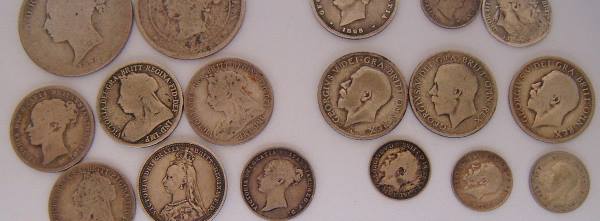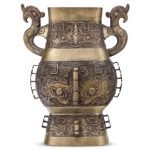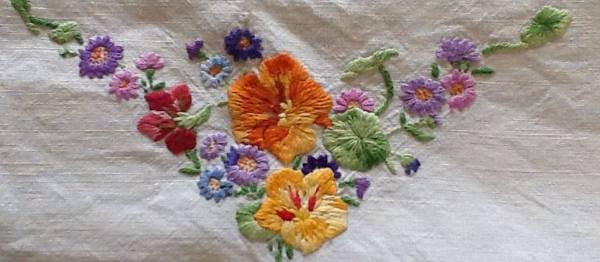Miniatures hand-painted on porcelain blanks have been recognised as a specialised area of European art and some overseas work mounted as brooches has been collected in Australia. Astute collectors are now seeking out similar items hand-painted in Australia.
Of particular interest are small porcelain medallions painted in Australia during the 1920-30s and suitably mounted as brooches. Such items were very popular in South Australia during the popularity of the Art Deco style in the 1920-30s. The silver or gold mounts often have additional intrinsic interest as evidence of the jeweller’s skills of that era. These were the years of a burgeoning consumerism and spending on fashionable new items for adornment.
In the 1930s, many families experienced a depressing loss of income and this doubtless influenced some women to look for more affordable items of adornment. Porcelain brooches, hand-painted by recognised artists were exhibited in prestigious art exhibitions, at lower prices than paintings, and were popular purchases.
They were even more affordable when exhibited without the mount as they could then be mounted at a later date for personal use or as a special gift. Women predominantly did this form of china painting, sometimes purely as a hobby, but many were single and strived to support themselves through their art practice. They required sales, hence imagery painted on brooches was chosen to appeal to women and not necessarily the male reviewers who were more concerned with the larger artworks exhibited.
Some artists continued to paint brooches in a conservative style throughout the 1930s. Floral imagery, especially roses and garden flowers, was always popular. Australian flora and birds such as kookaburras enjoyed a vogue in the late 1920s. China painters who had received formal art training painted miniature portraits and scenes on some brooches. Nevertheless, one interesting aspect of many brooches painted during this era was the manner in which individual artists introduced their own version of the Art Deco style. This knowledge is useful in dating their work as although the more professional china painters signed the back of their brooches, few added a date.
The influence of the ‘Modern’ style, now known as Art Deco, was widespread and varied somewhat.1 Some china painters used black to varying degrees as a visual emphasis on their porcelain brooches; other painters stylised their images, eliminating fussy edges and backgrounds. Most artists however were influenced to use clearer, brighter colours in their work.
One brooch of particular interest, possibly because it is the work of a male artist, depicts apple blossoms against a heavily painted black background. Although the leaves and blossoms appear at first glance to be simplified, the precise skill of the carefully placed relief enamels on the flowers and the careful shading in the shadows indicate a skilled artist. J. A. Peach is the printed signature on the back of the brooch and this could well be J Arthur Peach who taught china painting at East Sydney Technical College until about 1929. The sterling silver mount was added later and uses a design of grapes and vine leaves with indications that it was made in Sydney, possibly by Rhoda Wager c. 1939.2
A South Australian teacher and exhibitor of china painting was Maude E Gum. She trained under James Ashton, briefly attended the South Australian School of Arts and Crafts and exhibited paintings regularly with the Royal South Australian Society of Arts in the 1920s-40s. As well as exhibiting oils and watercolours, she included eleven china-painted brooches in her 1931 solo exhibition. Most of her brooches were painted in a conservative style and set in simple, narrow, silver, claw mounts, each with an attachment for a safety chain. Her brooch illustrated depicts a tranquil rural scene in which a woman wearing a white apron stands near a small boy seated adjacent to a stone bridge as he sails his toy yacht in the stream.
Mamie Venner and Gwynith Norton, also artists with a background of formal art training, frequently exhibited porcelain brooches in Royal South Australian Society of Arts Exhibitions. Both women were aware of, but not unduly influenced by, Art Deco trends. Instead, they preferred painting roses on many brooches, but in the more traditional formats that doubtless helped in the ready sale of their work to buyers who belonged to a conservative South Australian society.
Venner preferred painting pale pink and rich ruby roses, frequently against a mother-of-pearl lustre background and the brooch set in a gold mount. She was very familiar with the Art Deco use of lustres in china painting and used them to great effect.
Norton used a subtly different treatment in her paintings of roses on her brooches. Norton preferred to paint yellow-orange roses, slightly formalised her rose structures and showed a mild Art Deco influence in the way she often used firm, dark lines to establish movement and design flow around the brooch.
During the 1920s, Miss Gladys Good taught china-painting at the South Australian School of Arts and Crafts. Her classes were popular, her standards were high and she insisted on original design work. Most students were also enrolled in other subjects and graduated as proficient rounded artists. One such student was Jean Beurle who studied china-painting under Good in 1926. Beurle’s painting of a kookaburra perched on a branch amid wattle with a minimum of background distraction, is an accomplished piece. It is set in a silver mount, signed on the back and was painted c.1928.
Art Deco female images were often stylised even though the image itself could be taken from another period. The brooch painted by P. Hughes depicts a slightly stylised image of a well-groomed, educated young woman reading a slim volume. Although the dress fashion is not modern, the floral images painted on the dress are stylised Art Deco, as is the use of a fine black line around the image and on the porcelain rim. The brooch is mounted in a fully-backed brass frame inscribed with the artist’s name.
Images of the Madonna have long been popular on European hand-painted porcelain brooches. However, a small circular brooch of South Australian provenance has a more unusual and interesting religious image. It is a carefully copied segment of one of the evangelical symbols used to introduce St Mark’s Gospel in the Book of Kells. Unfortunately there is no signature on the back of this brooch hence the copying artist is unknown. The brooch is in a silver mount similar to that used for Norton’s brooch and Beurle’s brooch.
Other South Australian china painters used more imaginative Art Deco stylisation of flowers. An unframed, oval porcelain brooch hand painted and signed on the back by G. Durant is a case in point. Although somewhat lacking in design skills, her colourful images suggest a stylised attempt to depict eucalypt capsules. The use of thin black lines around the fruits and leaves, a wider black line around the porcelain rim and application of mother-of-pearl lustre as background, place this item firmly within the 1930s. The provenance is unknown apart from the fact that this and several similar pieces were obtained from a clearance sale at a property in the mid north of South Australia.
Hand-painted porcelain brooches like these have all been fired several times during the painting process and the artwork is permanent. The image on the porcelain will safely withstand light contact with silver cleaners, followed by careful washing by hand in lukewarm water and mild detergent and ending with a good rinse.
These small treasures may be safely worn today and provide unusual and attractive pieces of jewellery. However all porcelain can break if carelessly dropped and the addition of a safety chain is a wise precaution. Porcelain hand-painted brooches of the 1920-30s form a part of Australian women’s art/craft and social history and although becoming scarcer, are nonetheless worth seeking out, especially if something is known about the artist. So far, they also have the added advantage of remaining reasonably priced.






